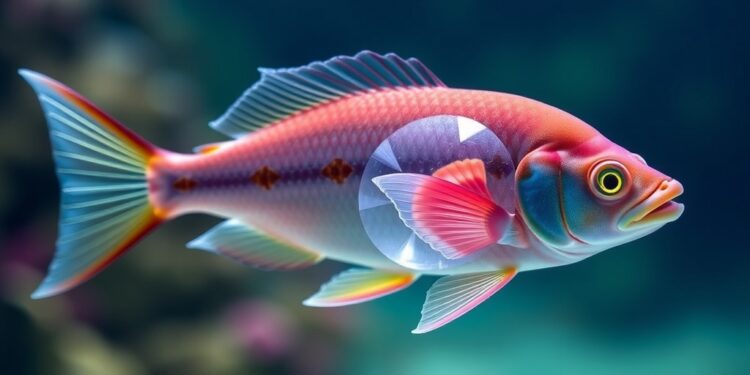Hydrogels, a class of soft materials produced by crosslinking polymers, are making significant strides in the field of regenerative medicine. Recent advancements highlight their promising potential in diverse medical applications, particularly in cardiac repair. A groundbreaking study published in the journal Advanced Science reveals the innovative use of an injectable hydrogel derived from fish swim bladders, showcasing its effectiveness in repairing damaged heart tissue. As the intricacies of such biological materials unravel, researchers are optimistic about the future of cardiovascular treatments.
The fish swim bladder is an organ that plays a crucial role in buoyancy for fish, composed primarily of collagen, glycosaminoglycans, and elastin. These structural components exhibit considerable similarity to the elements found in human heart tissue. This similarity underscores the potential of leveraging natural biomaterials in medical applications, particularly in emergencies such as myocardial infarction where rapid repair and recovery of heart tissue are vital. The study demonstrates how the unique biochemical properties of the fish swim bladder can be harnessed to create more effective hydrogels, facilitating significant advancements in cardiac repair strategies.
Experimental results from the study indicate that this innovative hydrogel based on fish swim bladder extracts significantly boosts cardiac cell adhesion and stretching. These enhancements are critical as they promote cellular interactions necessary for tissue healing and regeneration following an ischemic event. Moreover, the hydrogel encourages the formation of new blood vessels, a fundamental process known as angiogenesis, essential for restoring blood supply to damaged tissues and enhancing overall heart function.
The study also noted that the hydrogel triggers a positive immune response, fostering an environment conducive to healing and reducing inflammation. By actively promoting immune cell activities, the hydrogel helps in mitigating the detrimental effects of inflammation, which often complicate recovery after ischemic injuries. This multifaceted approach not only addresses the immediate damage caused by heart attacks but also sets the stage for long-term recovery of cardiac function.
In addition to cellular adhesion and vascularization support, the hydrogel offers sustained mechanical support for heart contractions. This functional assistance is particularly crucial as it parallels the natural biomechanical properties of the heart, allowing the myocardial tissue to regain its contractility following injury. In experimental settings, the hydrogel has demonstrated its ability to maintain normal heart rhythms and improve muscle performance, ultimately contributing to better cardiovascular outcomes.
Zhihong Wang, PhD, a leading researcher at Nankai University in China, emphasized the significance of this study in addressing the irreversible loss of cardiomyocytes that occurs during ischemic events. The development of novel regenerative strategies is essential, particularly given the limitations of current therapeutic options. By utilizing the bioactive properties of fish swim bladder-derived materials, Wang and his team are paving the way for future treatment modalities that may revolutionize myocardial repair and enhance patient recovery.
The findings from this research hold great promise, as the injectable hydrogel not only demonstrates compatibility with existing medical protocols but also introduces a groundbreaking method for repairing heart tissues. As the field of regenerative medicine evolves, such innovations may serve as a foundation for developing effective therapies aimed at other forms of tissue damage across various organ systems.
The implications of this research extend beyond mere anatomical repair; they offer insights into the biochemical interactions and cellular behaviors that are vital for tissue regeneration. While further studies are necessary to fully elucidate the mechanisms at play, the initial results suggest that hydrogels derived from biological materials could play a crucial role in enhancing recovery rates and improving quality of life for patients suffering from cardiovascular diseases.
As researchers and clinicians increasingly recognize the significance of patient outcomes, the need for materials that not only heal but also support the functionality of the heart becomes paramount. This hydrogel represents a substantial step towards the integration of biocompatible materials in future cardiovascular medicine, characterized by their inherent ability to support tissue repair while minimizing adverse reactions.
Moreover, the methodology employed in this study also raises questions about other potential applications for fish swim bladder-derived hydrogels. The adaptability of this approach could extend to various types of tissue engineering, influencing the way biologists and medical professionals approach regenerative therapies across different organ systems. As the scientific community continues to explore the versatility of these biopolymers, it may unlock new frontiers in treatment methodologies.
Subsequently, the success of the fish swim bladder hydrogel in addressing myocardial ischemic injury inspires future investigations into other natural sources of hydrogels. The world of marine biology, in particular, presents a rich repository of unexplored materials that could further impact the field of regenerative medicine. Researchers now face the exciting challenge of identifying other animal-based or plant-based materials that could complement or enhance the performance of existing hydrogels for various therapeutic applications.
In summary, the evidence presented in the study underscores the transformative potential of using biopolymer-based hydrogels to advance cardiac therapies. The integration of natural materials demonstrates a shift towards more holistic and sustainable methods of tissue repair, reflecting an overarching trend in medical research to prioritize biocompatibility and mechanistic support in regenerative approaches. Continued exploration of these innovative materials will likely yield promising results in the fight against cardiac ailments and other diseases requiring tissue regeneration.
In conclusion, this pioneering study heralds an exciting era of research centered around the application of biodegradable and biocompatible materials derived from natural sources. The effective use of fish swim bladder-derived hydrogels in treating ischemic heart injuries signifies a substantial leap forward in cardiac therapy and rejuvenation, ultimately aiming to improve health outcomes for countless individuals affected by cardiovascular diseases.
—
Subject of Research: Injectable Hydrogels from Fish Swim Bladders for Cardiac Repair
Article Title: Fish swim bladder-derived ECM hydrogels effectively treat myocardial ischemic injury through immunomodulation and angiogenesis
News Publication Date: 9-Apr-2025
Web References: https://advanced.onlinelibrary.wiley.com/journal/21983844
References: DOI – 10.1002/advs.202500036
Image Credits: Advanced Science
Keywords
Heart failure, Fish, Hydrogels, Tissue repair, Applied research




